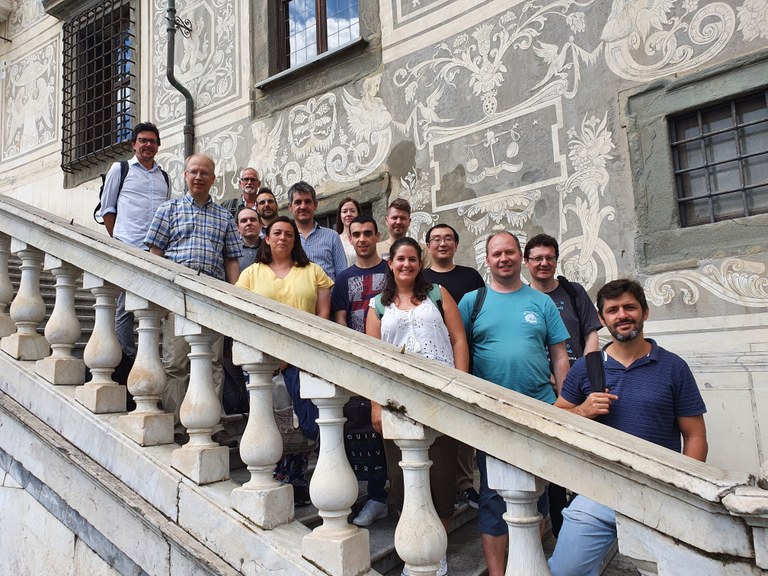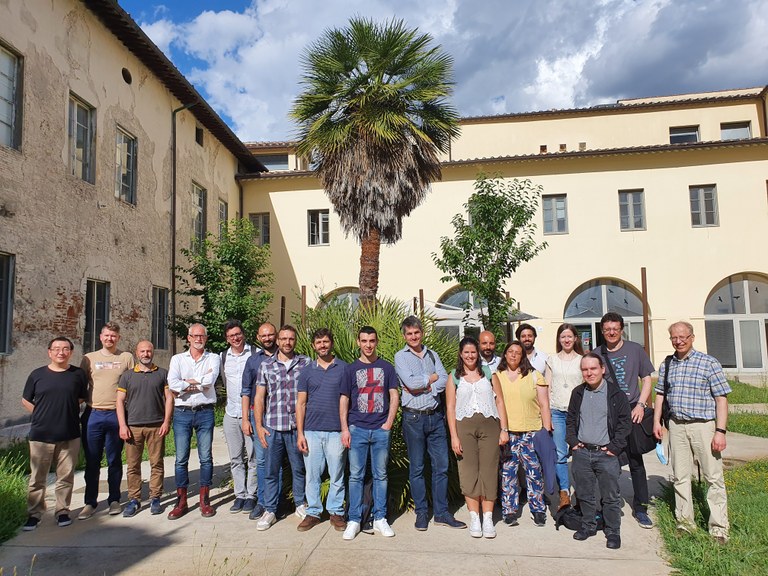SUPERTED 2022 meeting
The SUPERTED consortium members gathered to Pisa, Italy on 9th and 10th of June 2022 to have a face-to-face meeting after two years of remote calls. The meeting was organized by CNR Nano (Instituto Nanoscienze - Consiglio Nazionale delle Ricerche) and Scuola Normale Superiore. The meeting brought together more than 20 consortium members and selected invited speakers to discuss the final stretch of the project. The first day focused on the progress of the project, discussing each work package in detail. The second day consisted of scientific talks to share the latest advancements within each field involved in the project. Spirits were up as the participants took full advantage of carrying on discussions during the breaks and got to know consortium members that haven’t been able to join the previous face-to-face meetings.

Thursday 9th of June 2022
The first day was dedicated to discussing the project in detail. Each work package leader provided a short introduction to the progress that has been made and to the challenges that remain. Work package 1 focuses on sample growth. Accordingly, Celia Rogero discussed the growth and patterning of the ferromagnetic insulator / superconducting (FI/S) heterostructures to be implemented in the detectors. There are multiple attractive options to be tested but at this stage of the project, it is time to focus on the most promising setup and aim for prove of principle.
Work package 2 is dedicated to making and characterizing the detectors. Thus, Elia Strambini talked about making the detectors as well as their thermal and low-frequency characterization. The main challenges concern resistance and tunneling spectroscopy as the perfect sample seems to still elude the project. New samples will still be produced, and alternative solutions can be sought for antenna design to allow sample testing during the next step.
The presentations in work package 3 were divided according to the two main topics, single pixel THz and X-ray demonstrations. Alessandro Monfardini introduced the THz setup in Grenoble. However, they haven’t been able to confirm locally the same sample properties that have been seen in Pisa. As a strategy for the remainder of the project, step back is taken by not using lithography and attempting to confirm the properties seen in Pisa also in Grenoble. In addition, new lithography masks are considered, running both research lineages in parallel.
Ilari Maasilta was responsible for presenting the X-ray related topics of work package 3. Cryogenic and SQUID readouts are finally operational as the originally planned SQUID was never delivered and an alternative option has been obtained. Although it has not been possible to test the original SQUID in Jyväskylä, in theory the current SQUID does not perform as well in terms of readout noise. Good sample would be still needed but as of now, it is possible to settle for a less good option to keep going.
In work package 4, the focus is on technology transfer and exploitation. Francisco Lopez covered the current status and decisions that must be made towards the end of the project. Overall, the opportunities in WP4 have been limited because the detector signal has not been observed yet. To take the technology beyond the project duration, detailed description of how to build this type of a detector is required. It could be executed in form of a so-called detector package that would include 3D drawings of the detector setup. There is an opportunity to install the detector to Conference Underground Laboratory LSC in Spain where they currently use TES detectors for dark matter research.

In terms of communication and dissemination of work package 5, Sanna Rauhamäki reminded everyone of the remaining duties. There are several reports scheduled for the last month of the project, which means that everyone gets to report their work before the project is over. The dissemination activities have been slowly returning to the level where they were before the COVID-19 restrictions, although especially publishing press releases has been more active during the other reporting periods. In WP5 the main focus is currently on short film due at the end of August.
After the presentations, the day continued with a walk to NEST where the participants had the opportunity to tour the laboratory. The Pisa representatives introduced their facilities to eager audience, and the scientific discussion carried on from earlier. The day was concluded with an excellent dinner at near-by restaurant.
Friday 10th of June 2022
The second day dove into scientific topics surrounding the project. The meeting participants had the pleasure to start the day by listening quest speaker Marco Affronte from Unimore, the University of Modena and Reggio Emilia. Marco Affronte discussed his dark matter research and a related FET Open project Supergalax. The day continued with presentations from the SUPERTED consortium members, some focusing on topics that are directly linked to SUPERTED and some venturing to other, closely related topics. The first one to step into the spotlight was Alessandro Braggio, presenting his work on bipolar thermoelectricity in superconducting tunnel junctions. The morning session was concluded by Maria Spies discussing rectification in EuS-chalcogenide based superconducting tunnel junctions.
Second session was opened by Zhuoran Geng providing a detailed description to the progress on the X-ray calorimeter for SUPERTED project. The session proceeded with Maxim Ilin discussing materials science challenges of the superconducting tunneling devices. Tero Heikkilä concluded the session by presenting magnetization dynamics in superconductor / ferromagnet heterostructures.

Registration to the meeting
Please fill the participant information form by 6th of April 2022. The form has now been closed and the participants have been contacted to confirm their participation by 31st of May 2022.